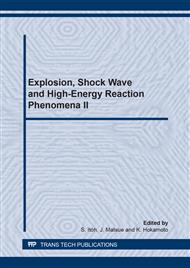p.120
p.126
p.132
p.138
p.144
p.150
p.154
p.160
p.166
High Strain Rate Test of a Steel Plate under Blast Loading from High Explosive
Abstract:
In this study, a high strain rate test method of a steel plate under blast loading from high explosive was designed and was conducted by a combined experimental/numerical approach to facilitate the estimation process for the dynamic stress-strain curve under practical strain rate conditions. The steel plate was subjected to a blast load, which was generated by Composition C4 explosive and the dynamic deformation of the plate was observed with a high-speed video camera. Time-deformation relations were acquired by image analysis. A numerical simulation for the dynamic behaviors of the plate identical to the experimental condition was conducted using a coupling analysis of finite element method (FEM) and discrete particle method (DPM). Explosives were modeled by discrete particles and the steel plate and other materials were modeled by finite element. The blast load on the plate was described fluid-structure interaction (FSI) between DPM and FEM. As inverse analysis scheme to estimate dynamic stress-strain curve, an evaluation using a quasistatic data was conducted. In addition, two types of approximations for stress-strain curve were assumed and optimized by least square method. One is a 2-piece approximation, and was optimized by least squares method using a yield stress and a tangent modulus as parameters. The other is a continuous piecewise linear approximation, in which a stress-strain curve was divided into some segments based on experimental time-deformation relation, and was sequentially optimized using youngs modulus or yield stress as parameter. The results showed that the piecewise approximation can gives reasonably agreement with SS curve obtained from the experiment.
Info:
Periodical:
Pages:
144-149
Citation:
Online since:
July 2013
Authors:
Price:
Сopyright:
© 2014 Trans Tech Publications Ltd. All Rights Reserved
Share:
Citation:


